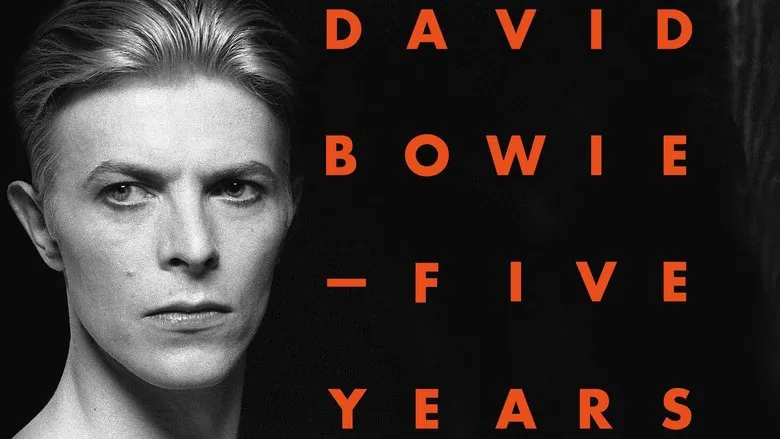The Chameleonic Spirit: Unpacking David Bowie’s Iconic Transformations in “Five Years”
The documentary “David Bowie: Five Years” isn’t merely a chronicle; it’s an intimate expedition into the audacious mind of a musical titan who consistently defied categorization. More than just a linear narrative, the film peels back the layers of persona, collaboration, and sheer creative drive that defined David Bowie’s most pivotal decades. It’s a behind-the-scenes look not at the making of the documentary itself, but at the creation of David Bowie, the ever-evolving artist who left an indelible mark on culture.
The Stardust Rises: Crafting an Alien Icon
The early 1970s saw the explosion of Ziggy Stardust, a flamboyant, gender-bending alien rock star who descended to Earth to deliver a message of hope through music. “Five Years” dives deep into the genesis of this legendary character, showcasing how Bowie, alongside his close collaborators like producer Tony Visconti, forged the soundscape of “The Rise and Fall of Ziggy Stardust and the Spiders from Mars.” The film utilizes unearthed archive footage that transports viewers directly into the recording sessions and the flamboyant live performances that quickly cemented Ziggy as a glam rock behemoth. It wasn’t just a character; it was a cultural phenomenon, meticulously crafted and unleashed upon a world ready for something radically new.

“At that time, David was just channeling something otherworldly,” Visconti recounts in the film, highlighting the almost spiritual connection Bowie had to his creations. The documentary effectively illustrates how Bowie didn’t just play Ziggy; he became him, pushing the boundaries of identity and performance long before it became commonplace.
From Glam to Soul: The Young American Phase
As the mid-70s approached, Bowie, with his innate restlessness, began his next dramatic metamorphosis. Shedding the crimson hair and cosmic theatrics of Ziggy, he embraced a smoother, more soulful persona, epitomized by the album “Young Americans.” “Five Years” expertly traces this unexpected pivot, revealing Bowie’s deep fascination with American rhythm and blues. Interviews with musicians like Chic’s guitarist Alfa Anderson, who collaborated on the hit single “Fame,” illuminate the significant influence soul music had on Bowie’s shifting sound.
This wasn’t just a stylistic change; it was a profound immersion, with Bowie absorbing influences and weaving them into his unique tapestry. The film showcases how this period was crucial in demonstrating Bowie’s unparalleled versatility, proving he wasn’t bound by any single genre or character.
Berlin’s Edge: The Experimental Avant-Garde
The late 1970s marked perhaps Bowie’s most profound creative re-evaluation, as seen through the documentary’s lens. Seeking artistic renewal and a quiet escape from global fame, he relocated to Berlin. Here, in the stark, divided city, he forged an incredibly fertile partnership with avant-garde maestro Brian Eno and the enigmatic Iggy Pop. “Five Years” highlights how this alliance led to the groundbreaking “Berlin Trilogy,” commencing with the stark, experimental masterpiece “Low” (1977).

Through insights from collaborators like guitarist Earl Slick on the equally acclaimed “Heroes” (1977), the film delves into the intense creative crucible that forged these albums. We learn how recording techniques were pushed, and how Bowie’s melancholic poetry met Eno’s electronic soundscapes, creating a unique synthesis that defined an era. His wife and muse, Angie Bowie, also lends crucial insights into this deeply personal yet creatively explosive period. The documentary successfully conveys the profound impact of Berlin’s atmosphere on Bowie’s artistic direction, showing how he deliberately challenged himself to explore uncharted sonic territories.
The Commercial Resurgence: A Global Dance
Bowie’s journey continued into the early 1980s, revealing yet another surprising transformation. Following the angular, post-punk influenced “Scary Monsters (and Super Creeps)” – another visionary collaboration with Brian Eno – Bowie embraced a more commercially accessible sound with “Let’s Dance” (1983). The documentary vividly portrays this shift, featuring candid interviews with Nile Rodgers, the Chic guitarist and producer who masterminded the album.
Rodgers’ accounts offer a fascinating glimpse into the making of a global phenomenon, detailing the fusion of Bowie’s artistic vision with Rodgers’ pop sensibilities. “Let’s Dance” wasn’t just a hit; it redefined Bowie’s commercial appeal, proving his ability to evolve and connect with a massive global audience without compromising his artistic integrity entirely. It showcased his relentless push against stagnation, continually reinventing his sound and image to stay relevant and groundbreaking.
The Enduring Legacy of a Shapeshifter
“David Bowie: Five Years” culminates not just with a re-telling of events, but with a profound reflection on Bowie’s lasting influence. The film masterfully weaves together interviews and archival materials to illustrate Bowie’s peerless innovation, his willingness to experiment, and his consistent collaborations with visionary artists. It demonstrates how his constant metamorphosis wasn’t a desperate search for identity, but rather a deliberate and artful expression of his multifaceted genius.

From inspiring rebellious youth as Ziggy Stardust to pushing the boundaries of sound in Berlin, and then conquering the pop charts, Bowie’s career was a series of fearless artistic leaps. The documentary unequivocally shows how his experimental nature continues to inspire generations of musicians, from the avant-garde to mainstream pop, cementing his status not just as a musician, but as a cultural architect whose visions continue to captivate and provoke. “David Bowie: Five Years” is a powerful testament to the man who truly made reinvention an art form.